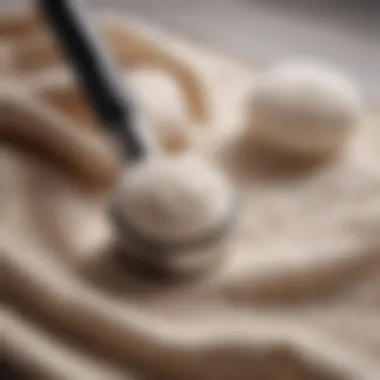The Art of Exfoliation: Care for Your Sensitive Areas


Intro
Exfoliation is a term that often conjures up images of spa days and elaborate skincare regimens. Yet, one area that frequently gets swept under the rug in these discussions is the private area. This isn’t just about aesthetics or keeping up with fashion trends; it’s about nurturing one of the most sensitive regions of your body. With proper care, you can promote skin health, maintain hygiene, and boost confidence. This guide will dive deep into the nuances of exfoliation for intimate areas, providing you with the know-how necessary for effective and safe practices.
Understanding how delicate skin responds to various products and techniques is crucial. Compared to other parts of the body, the skin in our private areas is thinner and more susceptible to irritation. Therefore, tailoring your exfoliation routine specifically for these zones can serve to enhance your overall well-being.
In the upcoming sections, expect to explore the importance of exfoliation, suitable techniques, recommended products, and safety tips to keep everything running smoothly. After all, knowledge is the first step toward making informed decisions about personal care. Let's step into this world of exfoliation and learn how to care for a part of the body that deserves utmost attention.
Prolusion to Exfoliation
When it comes to self-care, the art of exfoliation plays a pivotal role, especially in areas that often go unnoticed in discussions about skincare. It’s easy to forget that these delicate regions require just as much attention and care as the more commonly treated areas of the body.
Exfoliation isn’t just a trend; it’s a vital process for maintaining healthy skin. It works by removing dead skin cells, which can accumulate and lead to various concerns like irritation, dullness, and even ingrown hairs. By keeping the skin smooth and rejuvenated, exfoliation ultimately promotes a radiant and inviting surface.
Understanding Exfoliation
Exfoliation can be broadly categorized into two main techniques: physical and chemical. Physical exfoliation involves the manual removal of dead skin using scrubs or tools, while chemical exfoliants utilize acids or enzymes to dissolve dead skin cells.
Each method has its merits, and understanding these techniques is crucial for a safe and effective routine. For example, using a gentle scrub with fine granules may be suitable for tougher skin, whereas sensitive areas might respond better to a chemical agent like glycolic acid, which works by loosening the bonds that hold dead cells together.
It's essential to recognize that not all exfoliation is created equal. What works wonderfully for one person may lead to discomfort or adverse effects for another. Hence, thorough consideration of one’s skin type and sensitivity is fundamental.
"Exfoliation is like decluttering your skin – it clears away the old to make way for the fresh."
Why It Matters for the Private Area
The private area deserves specific attention when it comes to exfoliation. This delicate skin is often more sensitive than other parts, making it susceptible to various issues like irritation, friction, and even infections if not cared for properly.
Moreover, the benefits of exfoliating this particular region often extend beyond mere aesthetics. Regular exfoliation can help prevent painful ingrown hairs which tend to crop up after shaving. It also promotes better skin health by stimulating circulation in the area, which in turn can enhance the absorption of moisturizing products applied afterward.
Ultimately, integrating a conscientious exfoliation routine tailored to the unique needs of your private area can lead to significant positive changes. Whether you choose a physical scrub or a chemical solution, the key is to proceed with caution, opting for gentle formulations that respect the skin's integrity. Understanding why exfoliation matters for this specific region can empower individuals to take charge of their personal care, leading to both comfort and confidence.
Types of Exfoliation
When it comes to caring for the private area, knowing the different types of exfoliation is essential. Each method offers unique advantages and challenges, making it crucial to choose the right approach for your skin type and individual needs. Exfoliation isn't just about removing dead skin; it's about enhancing that delicate skin's overall health and appearance.
Physical Exfoliation Techniques
Physical exfoliation involves using external tools or scrubs to manually slough off dead skin cells. This method is direct and can be quite effective, but one must tread carefully. Overdoing it can lead to irritation or micro-tears in sensitive skin, which is a major red flag.
Some common physical exfoliation techniques include:
- Soft Scrubs: Gentle scrubs with fine granules designed specifically for sensitive areas are a great place to start. Look for options that contain natural ingredients like cane sugar or finely crushed oats to avoid harshness.
- Exfoliating Gloves: Wearing gloves made of exfoliating fabric can help you massage the skin while effectively removing dead cells. Just use them with a light touch—think gentle caress rather than a vigorous scrub.
- Loofahs or Sponges: If using a loofah, ensure that it is clean and soft. Regular replacement of such tools can prevent any bacterial growth, which could compromise skin health.
"Physical exfoliation can boost blood circulation while refreshing the skin, but go easy on sensitive regions—less is often more."
Chemical Exfoliation Agents
Chemical exfoliation relies on specific compounds to dissolve the bonds holding dead skin cells together, allowing them to slough off naturally. This method may be preferable for individuals who find physical exfoliation too harsh. However, understanding your skin type is critical when opting for chemical agents.


Common chemical exfoliants include:
- Alpha Hydroxy Acids (AHAs): These water-soluble acids, such as glycolic and lactic acid, help in brightening the skin. AHAs are excellent for those looking to improve surface texture and tone.
- Beta Hydroxy Acids (BHAs): Salicylic acid, a well-known BHA, is oil-soluble and can penetrate deeper into pores. It’s particularly advantageous for individuals prone to ingrown hairs or acne.
- Enzymatic Exfoliants: Derived from fruits, these gentle options help break down dead skin without any scrubbing. They’re often found in creams and masks, making them easy to incorporate into your routine.
Natural Home Remedies for Exfoliation
For those who prefer a more holistic approach, plenty of natural remedies can effectively exfoliate the skin without harsh chemicals or abrasive tools. These options are not only gentle but accessible, allowing for easy integration into your skincare routine. Here’re some popular picks:
- Oatmeal Scrub: Ground oatmeal mixed with honey creates a soothing scrub that’s perfect for sensitive skin. Oatmeal soothes irritation and nourishes the skin simultaneously.
- Coffee Grounds: Used coffee grounds make for a fantastic exfoliant due to their coarse texture. Mix them with coconut oil for added moisture.
- Yogurt Mask: Lactic acid in yogurt acts as a natural exfoliant. Applying yogurt to the skin for a short time can help brighten and refresh your private area.
These methods not only contribute to the removal of dead skin but also provide nourishment that’s vital for keeping that delicate area radiant.
Assessing Your Skin Type
Understanding the unique characteristics of your skin is essential when it comes to exfoliating your private area. Each individual's skin can vary greatly in type, sensitivity, and specific needs. Assessing your skin type not only informs your choice of exfoliation methods but also helps in preventing adverse reactions, ensuring a healthier routine. Notably, proper assessment enhances the benefits of exfoliation while minimizing risks. In the sensitive regions of the body, where skin is thinner and more delicate, the stakes are even higher. Therefore, recognizing your specific skin type is crucial.
Normal Skin Considerations
If you have normal skin, you might be in a good spot when it comes to exfoliating your private area. Normal skin is generally characterized by balanced oil production, few blemishes, and an even tone. Exfoliation for individuals with this skin type can be more straightforward.
- Technique Choice: You can pick either physical or chemical exfoliation without worrying too much about irritation. Look for gentle exfoliants that will lift away dead skin cells without disrupting the skin's natural barrier.
- Frequency: Once or twice a week is usually enough, depending on how your skin reacts over time.
Remember, even normal skin can benefit from hydration post-exfoliation. A mild moisturizer can go a long way in keeping the intimate area supple and healthy, preventing dryness after riding over those pesky dead skin cells.
Sensitive Skin Precautions
Sensitive skin, conversely, requires a more cautious approach. Characterized by a tendency to react poorly to products—be it through redness, itching, or burning—this skin type demands careful consideration in any exfoliation routine.
- Product Selection: Opt for gentle exfoliants, avoiding harsh scrubs or strong acids. Ingredients like lactic acid or finely milled natural exfoliants can be kinder to sensitive skin.
- Patch Test: Before applying any new product to the private area, conduct a patch test on a less sensitive skin spot. This precaution could save you from a nasty surprise.
- Limited Frequency: Less is more. Aim for once every 1-2 weeks, and always pay attention to how your skin reacts.
It's worth noting that maintaining moisture is critical. So after exfoliating, applying a calming moisturizer that’s fragrance-free can mitigate any potential irritation while keeping your skin soft.
Skin Conditions to Keep in Mind
If you have existing skin conditions—such as eczema, psoriasis, or folliculitis—pay extra attention while considering exfoliation. Each condition poses its specific challenges, and while exfoliation can sometimes help, it can also exacerbate issues when done incorrectly.
- Consult a Professional: If in doubt, consult a dermatologist before integrating exfoliation into your routine. They can offer tailored advice suited to your specific condition.
- Choose Wisely: Certain conditions may mean you should steer clear of exfoliation entirely. Gentle treatments or alternatives like chemical exfoliation specifically designed for sensitive skin might be recommended instead.
- Monitor Closely: Always keep an eye on how your skin responds. Changes—no matter how slight—should guide your future exfoliation choices.
Pro Tip: Balance is key. Listen to your skin and adjust your routine as needed.
Understanding the nuances of your skin type can make a world of difference in your exfoliation efforts. The right approach not only promotes a healthier skin barrier but also paves the way for a more effective and enjoyable personal care ritual.
Safe Exfoliation Techniques
Exfoliating the private area might not come up in daily conversations at the coffee shop, but it's a topic worth exploring. Many folks regard exfoliation as essential for maintaining healthy skin. When done right, it helps to remove dead skin cells, keeping the skin smooth and fresh. However, there's a fine line to walk, especially in sensitive areas. Getting it wrong can lead to irritation, discomfort, or even serious skin problems.
The importance of this topic cannot be overstated. Proper techniques ensure your skin stays healthy, preventing issues like ingrown hairs, and it also promotes a more even skin tone. So, understanding how to safely exfoliate sensitive regions is key to enhancing overall skin health.
Preparation: What to Know Before You Start
Before jumping into exfoliating, it’s vital to prepare. This isn’t a one-size-fits-all venture. Start by gathering the right tools and products. Ideally, look for gentle exfoliants—opt for products that are specifically formulated for sensitive skin. Also, consider your skin type; if you have sensitive skin, you'll want to avoid harsh scrubs or strong chemicals. Always do a patch test on a small area to see how your skin reacts before going further.


Another crucial tip is to maintain proper hygiene. Clean the area thoroughly before you begin. A warm shower is ideal, as it helps to open up the pores, allowing for more effective exfoliation.
Step-by-Step Guide to Exfoliation
Once you’re prepped and ready, follow these steps for a safe and effective exfoliation process:
- Choose the Right Timing
Aim for exfoliation either during or after your shower. The skin is softer and more pliable when it’s warm, making the process smoother. - Apply the Exfoliant
If you’re using a scrub, take a small amount and gently massage it into the skin using circular motions. Avoid putting too much pressure – your skin isn't steel, so there’s no need to scrub like a sailor in a storm. - Rinse Thoroughly
After you've exfoliated, rinse the area well with warm water. Make sure no product remains behind, as this could lead to irritation. - Pat Dry
Gently pat the area dry with a clean towel. Avoid rubbing, as this can irritate freshly exfoliated skin.
Post-Exfoliation Care
Taking care of your skin after exfoliating is just as important as the exfoliation process itself. Here are some steps to consider:
- Moisturize: Applying a gentle, fragrance-free moisturizer can soothe and hydrate the skin after exfoliation. This step helps to lock in moisture and protect the new skin.
- Avoid Irritants: In the days following your exfoliation, steer clear of harsh products. This includes perfumes, strong soaps, and any other irritants that could cause discomfort.
- Monitor Your Skin: Keep an eye on how your skin reacts after exfoliation. If you notice redness or irritation, take note of the products you've used, as they may need adjustments.
Remember, your skin is unique. What works for one person might not work for another, so feel free to tweak the steps!
Integrating these safe exfoliation techniques into your routine can lead to smoother skin, improved texture, and a general sense of well-being. Be mindful and take your time; after all, good things come to those who wait—all in good measure.
Common Mistakes to Avoid
When it comes to exfoliating the private area, understanding common mistakes is essential. Many individuals may find themselves caught in the web of misinformation or habits that could lead to skin irritation or other unwanted issues. Recognizing these pitfalls not only enhances the effectiveness of your exfoliation routine but also safeguards your skin. Exfoliation aims to smooth and refresh the skin; however, getting it wrong can have the opposite effect.
Over-Exfoliation Risks
Over-exfoliation is often seen as a blunder that is easy to make, especially when people are eager to achieve smooth skin quickly. The temptation to scrub hard or apply exfoliants too frequently can lead to severe skin irritation. This type of mistake often manifests as redness, itchiness, or even peeling skin.
- Some signs of over-exfoliation include:
- Red or inflamed skin
- Increased sensitivity
- Breakouts or skin rashes
It's crucial to recognize that the skin in the private area is particularly delicate. What might be a suitable frequency for your face may not hold true for more sensitive regions. Adhering to a balanced exfoliation schedule—typically once a week—is usually more effective than excessive approaches.
Using Inappropriate Products
Another significant misstep occurs when individuals opt for products that are not tailored for the private area. Ingredients like alcohol or harsh fragrances may work fine on other parts of the body but can wreak havoc down below.
- Some common inappropriate products to avoid include:
- Strong scrubs containing large particles
- Products with synthetic fragrances
- Alcohol-based toners
Instead, it is wise to select milder formulations designed specifically for sensitive skin. Look for gentle exfoliants with natural ingredients. Your skin deserves the right care!
Ignoring Skin Sensitivity Signs
Ignoring signs that your skin may be reacting negatively to exfoliation is a risky mistake. Everyone’s body is different, and what works wonders for one person may not fare well for another.
- Be attentive to these indicators:
- Persistent redness
- Burning or stinging sensations
- Unusual dryness or flakiness
Should you notice any of these symptoms, it may be time to scale back your routine or consult with a skincare professional. Always listen to what your skin is telling you; it often speaks louder than you might think.


Take note: Caring for your skin is like nurturing a plant—too much sun can scorch it, while too little can leave it wilting. Find that sweet spot to flourish!
By avoiding these common mistakes, your exfoliation endeavors can yield the smooth, healthy skin you desire. Understanding these elements fosters an environment of care and mindfulness towards your private area's health.
Integrating Exfoliation into Your Routine
Integrating exfoliation into your skincare routine is not just a matter of vanity; it nurtures your skin, promotes cellular turnover, and ensures your delicate areas remain healthy. The importance lies in the fact that consistent exfoliation helps to remove dead skin cells, allowing for better absorption of moisturizers and other skincare products. Moreover, it can prevent issues such as ingrown hairs and uneven skin texture, contributing to overall comfort and hygiene in sensitive regions. Establishing a routine for exfoliation ensures that it becomes a regular part of your self-care regimen rather than an afterthought.
Creating a Personalized Schedule
Crafting a personalized exfoliation schedule involves considering your skin type, lifestyle, and specific needs.
- Frequency: Generally, exfoliation may be done weekly for sensitive areas. However, if you have specific skin considerations, you can adjust accordingly. For instance, those with less sensitive skin might thrive with exfoliation twice a week, whereas anyone with conditions like eczema should tread carefully, perhaps limiting it to once every two weeks.
- Timing: Try to time exfoliation during moments when you can relax afterward. This gives your skin a chance to recover, especially if you're using more aggressive exfoliants.
Pairing with Other Skincare Practices
Pairing exfoliation with complementary skincare practices can enhance its effects and contribute towards maintaining skin health. Here are some best practices:
- Cleansing: Always start with a gentle cleansing routine. This prepares the skin, allowing the exfoliation process to be more effective.
- Moisturizing: Follow up with a soothing moisturizer. After exfoliating, your skin needs hydration to replenish the moisture lost during the process.
- Sun Protection: Ensure you apply sunscreen when planning to be outdoors, especially after exfoliation. Exposed skin after exfoliation is more susceptible to sun damage, so protecting it is crucial.
"Taking the time to understand your skin’s needs can turn exfoliating from a chore into a vital component of your skincare philosophy."
By carefully integrating exfoliation into your routine with these considerations in mind, you promote long-term skin health and comfort. Each step reinforces the others, creating a holistic approach to caring for your private area.
Expert Opinions on Exfoliation
When it comes to caring for sensitive areas of the body, expert opinions carry significant weight. Dermatologists and beauty professionals alike recognize that while exfoliation can yield remarkable benefits, it must be approached with specific considerations in mind. Understanding their insights offers invaluable guidance for individuals aiming to navigate this intricate aspect of personal care safely and effectively.
Insights from Dermatologists
Dermatologists often emphasize the necessity of a delicate touch when exfoliating the private area. The skin here is particularly prone to irritation and injury due to its thinness and sensitivity. Dr. Emily Jones, a board-certified dermatologist, notes, "Using overly abrasive products can lead to micro-tears in the skin, which not only causes discomfort but can also lead to infections." To this end, dermatologists advocate for gentle exfoliation methods that respect the unique needs of delicate tissue.
- Frequency: It’s generally advised to incorporate exfoliation into one's routine no more than once a week in these sensitive regions. This allows the skin to recover and regenerate, minimizing the risk of overexfoliation.
- Product Selection: Look for products that are pH-balanced. This helps in maintaining the natural acidity of the skin, which is crucial for protecting the skin's microbiome.
- Methods: Dermatologists favor chemical exfoliants, such as lactic acid or glycolic acid, over harsh scrubs. These agents can provide effective results without the physical abrasion that comes from scrubbing motions.
"Patients should always listen to their skin. If something doesn’t feel right, it’s crucial to stop and reassess."
Feedback from Beauty Professionals
Beauty professionals echo the sentiments of dermatologists, emphasizing the importance of individualized care. From their experience, it’s clear that every person’s skin is unique, thus, what works for one may not work for another. Janine, a seasoned esthetician, advises, "Sticking to brand names you trust and products formulated specifically for sensitive areas can help avoid mishaps. Sometimes less is more."
- Customized Routines: Professionals recommend starting with a test patch of any new product. Apply the product to a small area first to check for adverse reactions.
- Complementary Care: Pairing exfoliation with hydrating ingredients, such as aloe vera or hyaluronic acid, can soothe the skin post-exfoliation. This approach helps lock in moisture and reduce potential irritation.
- Client Education: Knowledge is power. Beauty professionals often find success in educating clients about the signs of irritation and when to seek further advice. Being proactive encourages clients to be more attuned to their skin's needs.
Epilogue
Exfoliation isn't just a luxury; it serves as a fundamental practice that can significantly enhance the health and appearance of your private area. In this article, we emphasized the distinct considerations necessary when approaching exfoliation in sensitive regions. Not only does it help remove dead skin cells and promote a smoother texture, but it also plays a vital role in preventing ingrown hairs and other skin irritations. Therefore, understanding and implementing safe exfoliation techniques can lead to more comfortable and healthier skin.
Recap of Key Points
- Importance of Exfoliation: Regular exfoliation helps maintain skin health by clearing away dead skin cells, allowing for new, healthy skin to surface. This is crucial for delicate areas where irritation can easily occur.
- Types of Exfoliation: We explored various methods, including physical, chemical, and natural remedies, so you can choose the approach that best suits your skin type and comfort level.
- Safety Measures: Emphasis was placed on assessing your skin type and following safe practices to avoid over-exfoliation or damage to sensitive areas.
- Common Missteps: Identifying and avoiding common mistakes ensures a safe and effective exfoliation process, which is particularly important for the area's sensitivity.
- Integration into Routine: Exfoliation should be a consistent part of your self-care regimen, tailored to your unique needs and paired with other skincare practices for optimal results.
Encouragement for Safe Practices
As we wrapped up this guide, it’s essential to underscore the importance of prioritizing safety. Always listen to what your skin is telling you. Use products formulated for sensitive skin, as they’re designed to minimize risk while still delivering benefits. When trying out a new exfoliation technique, start slowly and pay attention to any signs of irritation. Remember:
- Patch testing new products can help you avoid reactions.
- Maintain awareness of your body’s signals; discontinue use if discomfort occurs.
- Hydration and moisturizing post-exfoliation can help maintain skin barrier function.
Finally, care for your delicate areas with the same level of attentiveness you show the rest of your body. Exfoliation can be a valuable addition when done correctly, ensuring skin health and comfort. Approach it with knowledge and mindfulness, embracing this self-care routine as part of your overall wellness journey.







